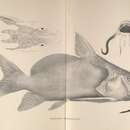Diagnostic Description
provided by Fishbase
Diagnosis: gill slits extending downwards beyond pelvic-fin insertions to the midline of isthmus; maxillary barbels not longer than head, lacking tubercles and ramifications, but with a broad, black membrane extending over their entire length; mandibular barbels with a broad black membrane; outer and inner mandibular barbels with few and simple ramifications, and membranous at tips; mandibular teeth short, numbering 8-16; pectoral-fin spines more strongly denticulate on inner than on outer margin; dorsal-fin spine smooth, except for weak serrations present on posterior margin in some specimens; humeral process deep, short, granular and not keeled ventrally; adipose fin high, long and contiguous to rayed dorsal fin (Ref. 57223).Coloration: typically inverted colour, the back being uniformly whitish-grey and the belly black; fins greyish, without spots; maxillary and mandibular barbels (particularly the outer pair) bordered by a broad, black membrane (Ref. 57223).
Diseases and Parasites
provided by Fishbase
Parasitic Mite Infestation (Acarina). Parasitic infestations (protozoa, worms, etc.)
Diseases and Parasites
provided by Fishbase
Clinostomum Infestation (metacercaria). Parasitic infestations (protozoa, worms, etc.)
Life Cycle
provided by Fishbase
Oviparous (Ref. 205). Distinct pairing during breeding (Ref. 205).
Migration
provided by Fishbase
Potamodromous. Migrating within streams, migratory in rivers, e.g. Saliminus, Moxostoma, Labeo. Migrations should be cyclical and predictable and cover more than 100 km.
Morphology
provided by Fishbase
Dorsal spines (total): 1; Analspines: 0
Trophic Strategy
provided by Fishbase
Feeds on plankton and detritus (Ref. 13868).
Biology
provided by Fishbase
Occurs in deep water close to the shore. Omnivore, feeds on plankton and detritus (Ref. 13868). May also feed on surface insects, chironomid larvae, benthic crustaceans, and mollusks (Ref. 28714). Oviparous (Ref. 205). Maximum size reported as 50.0cm (length type not given)(Ref. 31256).
Importance
provided by Fishbase
fisheries: commercial

